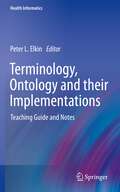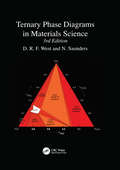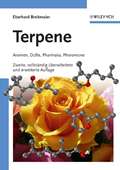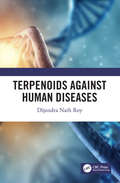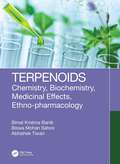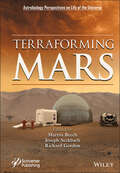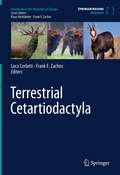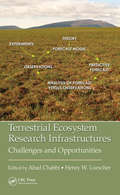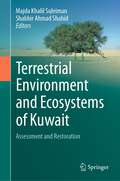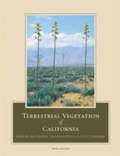- Table View
- List View
Terminology, Ontology and their Implementations: Teaching Guide and Notes (Health Informatics)
by Peter L. ElkinThis set of teaching notes provides extensive guidance for educators related to its sister title and contains numerous tools and questions to help educators provide didactics and evaluation of students in this essential area of biomedical informatics. This is needed to understand the central topics of ontology, terminology and terminological systems in healthcare. Twenty-five years ago the notion that ontology would be essential to knowledge representation in healthcare was all but unknown. Almost all important terminologies and many ontologies are now in wide use and are growing in importance. With no general model of what a ontology and terminology should be, there are an increasing number of tools to support ontology / terminology development, implementation and maintenance. Steady progress since then has improved both ontology / terminology content and the technology and processes used to sustain that content. Terminology, Ontology and their Implementations: Teaching Guide and Notes provides extensive teaching materials to accompany Terminology, Ontology and their Implementations . It provides further definition of the topic and explains the use of reference terminologies needed to use them safely. It contains questions and explanations from each section of the textbook, making it easier to use the text in teaching Health Informatics students. The authors also provide supplementary information about the questions, their relevance and their relation to other concepts. This book augments Terminology, Ontology and their Implementations by assisting the understanding of terminology services and the architecture for terminological servers, and consequently serves as an essential tool for educators in their efforts to teach students in their study of health informatics.
Termites (Nature's Children)
by Jen GreenDescribes the physical characteristics, habits, and habitats of termites.
Termofluidodinamica dei deflussi turbolenti: Fondamenti e modellazione
by Michele CiofaloIl testo fornisce i fondamenti teorici della turbolenza e una panoramica completa dei modelli di turbolenza, dai più semplici ai più avanzati, tra cui la simulazione diretta e la simulazione Large Eddy. Si concentra principalmente sui problemi di modellazione e calcolo e fornisce informazioni sulla teoria dei sistemi dinamici e sulle loro biforcazioni. Esamina anche aspetti della turbolenza che non sono trattati nella maggior parte dei libri esistenti su questo argomento, come la turbolenza in convezione libera e mista, la turbolenza transitoria e la transizione alla turbolenza. Il libro adotta la notazione tensoriale, che è la più appropriata per trattare quantità intrinsecamente tensoriali come le sollecitazioni e i tassi di deformazione, e per coloro che non hanno familiarità con essa viene fornita un'appendice sull'algebra tensoriale e sulla notazione tensoriale.
Termofluidodinamica: Problemi insoliti con soluzioni analitiche
by Michele CiofaloQuesto libro raccoglie dieci problemi di termofluidodinamica che richiedono l'uso di soluzioni analitiche. Tutti i problemi discussi sono stati affrontati dall'autore durante la sua attività di ricerca, alcune delle soluzioni sono un suo contributo, mentre altre sono risultati classici della letteratura o possono essere derivate da essi. I fenomeni fisici coinvolti vanno dall'idrodinamica pura al flusso con trasferimento di calore o di massa, al flusso bifase e alla magnetoidrodinamica. I problemi discussi non sono canonici; si trovano raramente nei libri di testo e spesso presentano soluzioni sorprendenti o addirittura paradossali. I lettori potenziali del volume sono studenti, docenti e scienziati in campo scientifico e ingegneristico interessati alla fluidodinamica e al trasferimento di calore/massa: a loro potrà offrire spunti di riflessione, suggerimenti per lezioni o esercitazioni e idee per ulteriori sviluppi originali.
Ternary Alloys Based on II-VI Semiconductor Compounds
by Vasyl Tomashyk Petro Feychuk Larysa ShcherbakDoped by isovalent or heterovalent foreign impurities (F), II-VI semiconductor compounds enable control of optical and electronic properties, making them ideal in detectors, solar cells, and other precise device applications. For the reproducible manufacturing of the doped materials with predicted and desired properties, manufacturing technologists
Ternary Alloys Based on III-V Semiconductors
by Vasyl TomashykIII-V semiconductors have attracted considerable attention due to their applications in the fabrication of electronic and optoelectronic devices as light-emitting diodes and solar cells. Because of their wide applications in a variety of devices, the search for new semiconductor materials and the improvement of existing materials is an important field of study. This new book covers all known information about phase relations in ternary systems based on III-V semiconductors. This book will be of interest to undergraduate and graduate students studying materials science, solid state chemistry, and engineering. It will also be relevant for researchers at industrial and national laboratories, in addition to phase diagram researchers, inorganic chemists, and solid state physicists.
Ternary Alloys Based on IV-VI and IV-VI2 Semiconductors
by Vasyl TomashykIV-VI and IV-VI2 semiconductors are among the most interesting materials in semiconductor physics. The electrical properties of these semiconductors can also be tuned by adding impurity atoms. These semiconductors either have already found use or are promising materials for infrared sensors and sources, thermoelectric elements, solar cells, memory elements, etc. The basic characteristics of these compounds, namely, narrow bandgap, high permittivity, relatively high radiation resistance, high mobility of charge carriers, and high bond ionicity, are unique among semiconductor substances. Because of their wide application in various devices, the search for new semiconductor materials and the improvement of existing materials is an important field of study. Doping with impurities is a common method of modifying and diversifying the properties of physical and chemical semiconductors. This book covers all known information about phase relations in ternary systems based on IV-VI and IV-VI2 semiconductors, providing the first systematic account of phase equilibria in ternary systems and making research originally published in Russia accessible to the wider scientific community. This book will be of interest to undergraduate and graduate students studying materials science, solid state chemistry, and engineering. It will also be relevant for researchers at industrial and national laboratories, in addition to phase diagram researchers, inorganic chemists, and solid-state physicists.FEATURES Provides up-to-date experimental and theoretical information Allows readers to synthesize semiconducting materials with predetermined properties Delivers a critical evaluation of many industrially important systems presented in the form of two-dimensional sections for the condensed phases
Ternary Phase Diagrams in Materials Science
by D. R. WestThis book serves undergraduates, postgraduates, and scientists in materials science who wish to acquire or extend their understanding of ternary phase diagrams. Emphasis is given to the use of phase diagrams as a means of understanding phase changes that occur as a function of temperature.
Ternary and Multinary Compounds: Proceedings of the 11th International Conference, University of Salford, 8-12 September, 1997 (Institute Of Physics Conference Ser. #152)
by R D Tomlinson; A E Hill; R D PilkingtonMultinary compounds are now used in a wide range of devices, including photovoltaic solar cells, light emitters and detectors, and piezoelectric actuators. Ternary and Multinary Compounds provides an interdisciplinary forum for scientists and engineers working on fundamental and applied aspects of these materials. The volume focuses on optoelectronic properties, electronic band structure, charge carrier transport, optical and magnetic properties, and superconductivity. It includes chapters on the research and development of new techniques and novel materials, such as laser ablation deposition and ferroelectrics.
Terpene: Aromen, Düfte, Pharmaka, Pheromone (Teubner Studienbücher Chemie Ser.)
by Eberhard BreitmaierDieses einfuhrende Lehrbuch bietet Studenten der Chemie, Biochemie, Biologie und Pharmazie eine perfekt strukturierte und kompakte Ubersicht uber die faszinierende Welt der Terpene. Der Leser lernt die Systematik der Terpenstrukturen, Vorkommen, biologische, olfaktorische und pharmakologische Wirkungen kennen, aber auch ausgewahlte Totalsynthesen (z.B. von Insektenpheromonen und Baccatin III als Vorstufe des Antikrebsmittels Taxol) und wichtige industrielle Herstellungsverfahren fur Riechstoffe und Vitamin A werden prasentiert. Die zweite Auflage ist vollstandig uberarbeitet und enthalt einige zusatzliche Abschnitte, u.a. uber Biogenese, polycyclische Monoterpene, Cannabinoide, Ginkgolide und Geo-Hopane. Aus dem Inhalt: * Terpene - Bedeutung, Bauprinzip, Biosynthese * Hemi-, Mono-, Sesqui-, Di-, Sester-, Tri- Tetra- und Polyterpene * biologische, olfaktorische und pharmakologische Eigenschaften * ausgewahlte Terpen-Synthesen * Isolierung und Strukturaufklarung"
Terpenoids Against Human Diseases
by Dijendra Nath RoyThis book highlights how terpenoids act as biological messengers and can be used as medicine against liver disease, neurodegenerative disease, cancer, infectious disease, cardiovascular disease, and inflammatory diseases. It emphasizes the metabolic engineering approach of terpenoids production and their toxicity.
Terpenoids: Chemistry, Biochemistry, Medicinal Effects, Ethno-pharmacology
by Biswa Mohan Sahoo Bimal Krishna Banik Abhishek TiwariThis unique volume covers specific aspects of the biological chemistry of terpenoids. It provides extensive information related to classification, general methods of extraction and isolation of terpenoids, synthesis and pharmacological activities of monoterpenoids, synthesis and medicinal uses of diterpenoids, biogenesis of terpenoids, synthesis and medicinal uses of sesqui terpenoids and sesterpenoids. Some terpenes are also classified as diterpene alkaloids. Most of the terpenoids with diverse molecular structures are biologically active and are used for the treatment of various diseases such as cancer, malaria, inflammation, tuberculosis and infection, and this is discussed. Features: Activities and biological relationships of terpenes An accurate assessment of where and what terpenes can lead to Discusses how microbes, in particular the actinomycetales, have well over 400 different gene clusters that produce terpenes Arranged by biological activities and usage Provides information on eukaryotic enzymes that have been shown to be a source of “ethnobotanical” terpenes
Terra Preta: How the World's Most Fertile Soil Can Help Reverse Climate Change and Reduce World Hunger
by Tim Flannery Hans-Peter Schmidt Kathleen Draper Haiko Pieplow Ute ScheubTerra preta is the Portuguese name of a type of soil which is thought to have almost miraculous properties. The newspapers are flooded with reports about "black gold," scientists believe that two of the greatest problems facing the world - climate change and the hunger crisis - can be solved by it. The beauty of it is that everyone can do something about it because since 2005 the secret of producing this black soil has been revealed - and it is a secret that seemed to have been lost forever with the downfall of the once thriving Indian culture of the Amazon basin. The recipe is astonishingly simple as all you need are kitchen or garden wastes, charcoal and earthworms, so it can be produced on every balcony or on the smallest of garden plots.The trio of authors Scheub, Pieplow and Schmidt, set off on a treasure hunt and condensed all the knowledge about the world's most fertile soil into a convenient guidebook. In addition to a sound instruction manual on producing terra preta and organic charcoal (biochar), the handbook covers fundamental principles from climate farming to closed-loop economy. It makes a passionate plea against synthetic fertilizers and genetic technology and offers indispensable advice to all those who feel strongly about healthy food.
Terraforming Mars (Astrobiology Perspectives on Life in the Universe)
by Richard Gordon Martin Beech Joseph SeckbachThe idea of terraforming Mars has, in recent times, become a topic of intense scientific interest and great public debate. Stimulated in part by the contemporary imperative to begin geoengineering Earth, as a means to combat global climate change, the terraforming of Mars will work to make its presently hostile environment more suitable to life - especially human life. Geoengineering and terraforming, at their core, have the same goal - that is to enhance (or revive) the ability of a specific environment to support human life, society, and industry. The articles in this text, written by experts in their respective fields, are accordingly in resonance with the important, and on-going discussions concerning the human stewardship of global climate systems. In this sense, the text is both timely and relevant, and will cover issues relating to topics that will only grow in their relevance in future decades. The notion of terraforming Mars is not a new one, as such, and it has long played as the background narrative in many science fiction novels. This book, however, deals exclusively with what is physically possible, and what might conceivable be put into actual practice within the next several human generations.
Terraforming: The Creating of Habitable Worlds
by Martin BeechThis book proposes a sound and realistic exploration on the topic of terraforming. Often used as the narrative premise in science fiction novels, terraforming is the process by which an uninhabitable planet might be converted into one capable of supporting life. This book presents what is physically possible today and hints what might conceivably be put into practice in the next several hundred years. The author works within the realms of current technology and known physics, although speculation on future advancements inevitably enters the discussion. Introductory chapters establish why terraforming will be of great benefit to human kind, and also put in place the basic physical arguments necessary to the terraforming process. The following parts look at various proposals that have been made for terraforming the planets Mars and Venus. The book concludes with a glimpse to the much deeper future when humankind will explore and colonize the outer solar system and possibly the newly discovered exoplanets.
Terrestrial Cetartiodactyla (Handbook of the Mammals of Europe)
by Frank E. Zachos Luca CorlattiThis volume provides comprehensive overviews of each terrestrial cetartiodactyl species’ biology including palaeontology, physiology, genetics, reproduction and development, ecology, habitat and diet. Their economic significance and management, as well as future challenges for research and conservation are also addressed. Each chapter includes a distribution map, a photograph of the animal and key literature. This authoritative volume of the Handbook of the Mammals of Europe is a timely and detailed compilation of all European terrestrial cetartiodactyls and will appeal to academics and students in mammal research, as well as to professionals dealing with mammal management, including control, use and conservation.
Terrestrial Coastal Ecosystems in Germany and Climate Change (Ecological Studies #245)
by Ulrich Irmler Dietrich MossakowskiClimate change is one of the most severe dangers for mankind worldwide. Beside the temperature increase, the sea level will rise and flood wide coastal areas, which is already remarkable today. The effects will be dramatic, in particular, at coasts with low elevation gradients such as at the German coasts of the North and Baltic Sea. The impact will be not only severe for coastal people, but still more for the unique coastal ecosystems, which harbors many plant and animal species that are already endangered today.This book focuses on the coastal terrestrial ecosystems of the German North and Baltic Sea. It describes the reactions of plants and animals (i.e. spiders, carabid beetles, bees and nematodes) on the future temperature and sea level increase. The combination of field and experimental studies is unique for Europe and for many parts of the world. It not only studies the actual elevation gradients and the climatic and saline gradients from West to East, but also the historical changes to document processes at coastal ecosystems that were already passed. In contrast to many books that studied the marine processes with similar backgrounds, this book concerns the terrestrial coastal ecosystems that were overall rarely studied and, in particular, never studied under this specific viewpoint.
Terrestrial Ecosystem Ecology
by Göran I. Ågren Folke O. AnderssonHuman activities impact the environment and modify the cycles of important elements such as carbon and nitrogen from local to global scales. In order to maintain long-term and sustainable use of the world's natural resources it is important that we understand how and why ecosystems respond to such changes. This book explains the structure and functioning of terrestrial ecosystems, using examples ranging from the Arctic to the tropics to demonstrate how they react under differing conditions. This knowledge is developed into a set of principles that can be used as starting points for analysing questions about ecosystem behaviour. Ecosystem dynamics are also considered, illustrating how ecosystems develop and change over a range of temporal and spatial scales and how they react to perturbations, whether natural or man-made. Throughout the book, descriptive studies are merged with simple mathematical models to reinforce the concepts discussed and aid the development of predictive tools.
Terrestrial Ecosystem Research Infrastructures: Challenges and Opportunities
by Abad Chabbi Henry W. LoescherTerrestrial Ecosystem Research Infrastructures: Challenges and Opportunities reveals how environmental research infrastructures (RIs) provide new valuable insights on ecological processes that cannot be realized by more traditional short-term funding cycles and are integral to understand our changing world. This book bonds the latest state-of-the-science knowledge on environmental RIs, the challenges in creating them, their place in addressing scientific frontiers, and the new perspectives they bear. Each chapter is thoughtfully invested with fresh viewpoints from the environmental RI vantage as the authors explore and explain many topics such as the rationale and challenges in global change, field and modeling platforms, new tools, challenges in data management, distilling information into knowledge, and new developments in large-scale RIs. This work serves an advantageous guide for academics and practitioners alike who aim to deepen their knowledge in the field of science and project management, and logistics operations.
Terrestrial Environment and Ecosystems of Kuwait: Assessment and Restoration
by Majda Khalil Suleiman Shabbir Ahmad ShahidThis book is an outcome of collaborative efforts of a multidisciplinary team of scientists. The core objective of this book is to provide cross-sectoral information on the different aspects of the terrestrial environment and ecosystems of Kuwait. The book will be considered as a ready source of information for those seeking information on the terrestrial environment and ecosystems, assessment and restoration, as well as sustainable uses and management. In spite of Kuwait’s hyper-arid environment, it is rich in natural resources including a wide range of native plants, animal species, different habitats, protected areas, diversified soils and water and oil resources. While the desert of Kuwait constitutes various features, such as sand sheet, sand dunes, nebkhas, inland and coastal sabkhas, rock outcrop, wadis and farming areas, it is rich in flora and fauna (native plants, mammals, birds, reptiles, etc.). Due to changing climate, deserts of Kuwait as well as other countries are under severe threat of degradation and the degradation may be irreversible. To realize these impacts, an effort is being made to provide a ready source of information to highlight the potential threats to the terrestrial ecosystems and formulate adaptation and mitigation strategies for long-term ecosystems services in Kuwait as well as other countries located in a desert environment, such as Gulf Cooperation Council Countries, Africa and countries in the Arab region. The book includes sixteen chapters covering multidiscipline subjects (such as natural resources, climate and climate change, geographical features, terrestrial habitats, ecosystems and threats, water and soil resources, agriculture, food security, water-energy-food-climate nexus, green-grey-blue water footprints of various crops, etc.). Thus, this book is a unique resource that provides the latest scientific information in a single volume.
Terrestrial Isopod Biology (Advances In Crustacean Research Ser. #Vol. 9)
by A.M. AlikhanThis text contains the papers of a meeting on American isopods, the only crustacean group with representatives in all terrestrial ecosystems ranging from the sea shore to the desert. Due to such adaptibility, this group can be seen as a model for the successful transition on land. The text deals with two main subjects: the effects of stressful conditions on the individual animal as reflected by its survival or by the disruption of its normal reproductive pattern; and the distribution of the isopods and their selection of microhabitat.
Terrestrial Photosynthesis in a Changing Environment
by Hipólito Medrano Jaume Flexas Francesco LoretoUnderstanding how photosynthesis responds to the environment is crucial for improving plant production and maintaining biodiversity in the context of global change. Covering all aspects of photosynthesis, from basic concepts to methodologies, from the organelle to whole ecosystem levels, this is an integrated guide to photosynthesis in an environmentally dynamic context. Focusing on the ecophysiology of photosynthesis - how photosynthesis varies in time and space, responds and adapts to environmental conditions and differs among species within an evolutionary context - the book features contributions from leaders in the field. The approach is interdisciplinary and the topics covered have applications for ecology, environmental sciences, agronomy, forestry and meteorology. It also addresses applied fields such as climate change, biomass and biofuel production and genetic engineering, making a valuable contribution to our understanding of the impacts of climate change on the primary productivity of the globe and on ecosystem stability.
Terrestrial Photosynthesis in a Changing Environment
by Hipólito Medrano Jaume Flexas Francesco Loreto Jaume Flexas Francesco LoretoUnderstanding how photosynthesis responds to the environment is crucial for improving plant production and maintaining biodiversity in the context of global change. Covering all aspects of photosynthesis, from basic concepts to methodologies, from the organelle to whole ecosystem levels, this is an integrated guide to photosynthesis in an environmentally dynamic context. Focusing on the ecophysiology of photosynthesis – how photosynthesis varies in time and space, responds and adapts to environmental conditions and differs among species within an evolutionary context – the book features contributions from leaders in the field. The approach is interdisciplinary and the topics covered have applications for ecology, environmental sciences, agronomy, forestry and meteorology. It also addresses applied fields such as climate change, biomass and biofuel production and genetic engineering, making a valuable contribution to our understanding of the impacts of climate change on the primary productivity of the globe and on ecosystem stability.
Terrestrial Vegetation of California (3rd edition)
by Michael G. Barbour Todd Keeler-Wolf Allan A. SchoenherrThis thoroughly revised, entirely rewritten edition of what is the essential reference on California's diverse and ever-changing vegetation now brings readers the most authoritative, state-of-the-art view of California's plant ecosystems available. Integrating decades of research, leading community ecologists and field botanists describe and classify California's vegetation types, identify environmental factors that determine the distribution of vegetation types, analyze the role of disturbance regimes in vegetation dynamics, chronicle change due to human activities, identify conservation issues, describe restoration strategies, and prioritize directions for new research. Several new chapters address statewide issues such as the historic appearance and impact of introduced and invasive plants, the soils of California, and more.
Terrestrial and Inland Water Environment of the Kaliningrad Region: Environmental Studies In The Kaliningrad Region (The Handbook of Environmental Chemistry #65)
by Andrey G. Kostianoy Vladimir A. Gritsenko Vadim V. Sivkov Artem V. YurovThis volume concisely and systematically presents our current knowledge of the terrestrial environment and inland water resources in the Kaliningrad Region. The 22 chapters, including an introduction and a conclusion, are based on observational data; scientific literature, mainly published in Russian; and the authors’ long-standing experience in this area of research. The book is intended for specialists working in various fields of environmental sciences and ecology; water resources and management; land reclamation and agriculture; and international cooperation in the Baltic Sea Region. This is the first of four volumes on Environmental Studies in the Kaliningrad Region. The other three volumes, to be published in the coming years, will be devoted to the physical oceanography, geoecology and bioecology of the Southeastern Baltic Sea.
